Foraging wild edible plants is excellent time spent outdoors. Probably the best aspect of foraging is that you don’t need to set time aside for it. As long as you’re spending time outdoors and can keep your eyes open for tasty edibles, you’re foraging.
It’s a worthwhile skill to learn and share with friends and family, but it can potentially be a major component of a survival strategy. Most wild plants don’t provide a heavy dose of calories, but they contain the essential vitamins, minerals, and fiber needed for a healthy diet.
Learning what you should and shouldn’t eat outdoors is a fun endeavor to explore as long as you head into it with the right perspective. Make sure to check out my guide on the basics of foraging before you start tasting everything you find.
Bring the Right Tools
If you’re gathering a large assortment of plants to eat, it’s wise to carry a foraging basket of some sort. People use wicker baskets and similar items for a reason; they’re light and breathable and tend to minimize any bruising and wilting of plants.
Gloves are a valuable tool to have at your side when foraging. They protect the hands (the only pair you’ve got, so take care of ‘em), but everybody is different with what they like to wear.
My coworkers wear thick leather gloves for all manner of work, but I’m a fan of thin and breathable gloves like these (Amazon Link).
They’ve always provided me with ample protection from all but the worst of thorns, and they’re thin and light enough to never be a problem to carry.
11 Wild Edible Plants
1. Clover
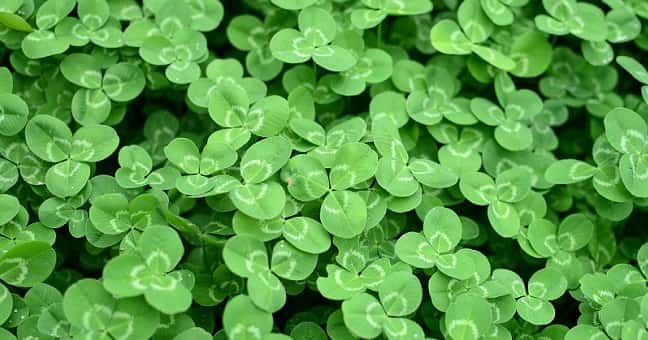
I place clover first on our list because it’s likely the one you’re most familiar with and will have the easiest access to find. You can cook it like spinach, eat it raw, or steep it into a tea.
Clover has lots of protein and the flower heads can be ground into flour.
Never choose brown or wilted clover to eat; these plants should always be fresh or dried by your own hand.
Some people are allergic to clover, so go easy on it at first if you’re unsure of your tolerances.
The flowers are the best tasting part.
2. Daylily

Beautiful as it is nutritious, the daylily is a mostly wild edible plant. The leaves are delicious when young (before they reach about six inches tall), and the flower buds are tasty when eaten raw or cooked.
Daylilies are perennial plants, and they grow relatively quickly.
Individual plants can be dug out and divided every three years or so, and each chunk of root can be used to start another plant. This is an easy way to guarantee a solid food crop for years to come.
3. Cattails
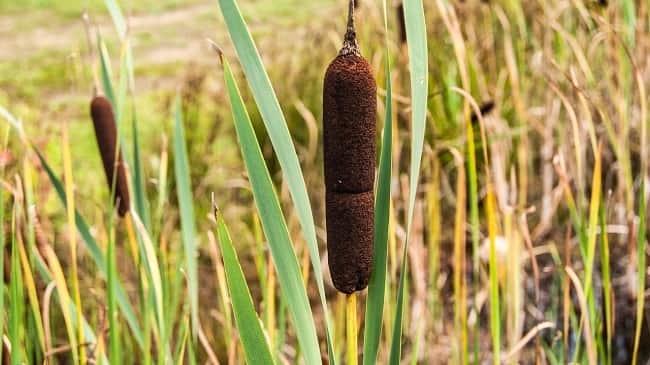
An iconic plant of marshlands, the cattail is a prolific grower and is full of starchy goodness.
The large chunk of seeds at the top of the plant (they look an awful lot like a corndog) can be cooked and eaten like corn on the cob. The leaves can also be cooked like spinach.
Be wary of where you’re foraging this wild edible plant. It grows in marshes and wetlands, and these areas are unfortunately polluted by industry and garbage. Survey the environment before eating any cattails.
4. Dandelion

If you’re noticing a trend towards familiar and easily-accessible wild edible plants, you’re right.
Dandelion is an excellent food full of antioxidants and minerals. The young leaves taste best, but the larger ones can be boiled to remove the bitter flavor. Drink that water as a tea, if you’re inclined.
Recommended Reading – How To Forage For Tea
Dandelion wine is a tasty drink if you’re inclined towards a bit of booze.
Like the warning about cattails above, dandelions are prone to exposure to pollutants and especially nasty chemicals.
Americans detest this attractive, edible, and beneficial “weed” in their lawns, so many places where dandelions grow will be bombarded with weed killers to eliminate its presence.
5. Berries

Hey, now we’re talkin’!
Edible berries can be found in a variety of places, but most tend to do well on woodlines and in old farmers’ fields growing near fence lines. Blueberries, raspberries, blackberries, and more can be found, depending on your region.
Berries are a delicacy among foragers, but they also serve an important role in the food web. Unless you’re in a survival situation, never eat more than your fair share. Always watch out for other foragers like bears who love to tear through a berry patch.
My favorites are black cap raspberries. You find them, and you give me a call, deal?
Also read our guide to poisonous berries.
6. Wood Sorrel

This plant looks an awful lot like a huge, angular version of clover, but it’s a different wild edible plant altogether.
Identify it by finding the three large green leaves that are angular and shaped like a giant clover. It tends to grow in areas where it gets a bit of shade.
It’s got a lemony and sour taste to the leaves that can be eaten raw. Add it to your diet for a boost of vitamin C or as a nice flavor pairing to make other greens more edible.
Or because you want to taste a bit of sour grass, I wouldn’t blame you because I do it too.
7. Japanese Knotweed

I’ve got a personal beef with this plant. It’s an invasive species that grows very rapidly, as much as thirteen feet tall in a single season, and aggressively spreads out via rhizome to dominate any area it is introduced to. I suppose that at the very least, this makes it a reliable wild edible plant if the SHTF.
The young shoots that come up in the spring are the best time to eat Japanese knotweed. Some people say it tastes a bit lemony, while others swear it’s closer to asparagus.
I wouldn’t know because I do battle with this plant on a regular basis during my day job.
8. Prickly Pear Cactus

Although it grows in many ornamental gardens, you won’t find this wild edible plant in the wild unless you’re in a desert locale.
It’s an attractive plant and easily identifiable by its flat, spiked arms. The fruit it produces will grow on the top of each “lobe” and is ripe when it turns red. The rest of the green is edible and full of water if you’re patient enough to remove all of the spines.
Read more about eating and preparing prickly pear.
Even with the fruit, take special care to remove every thorn and prickly bit to avoid a very painful situation.
9. Crab Apple
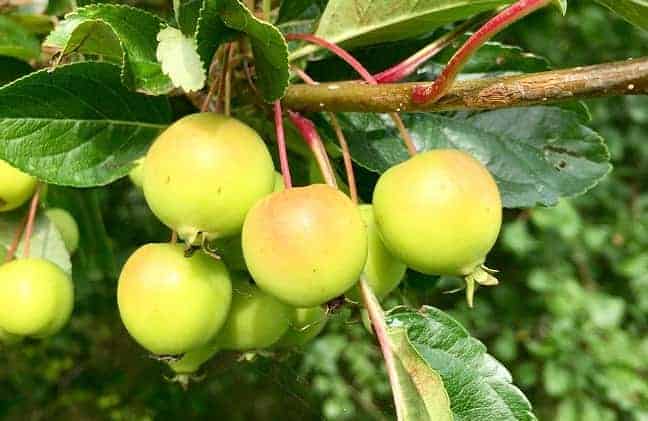
I’m placing crab apples on here because I grew up eating this wild edible plant. In fact I have written an in-depth piece on the many uses of the crab apple tree.
Sure, I was told not to because they’d give me stomach aches and all that, but here I am today to tell you all about them.
Whenever you find an apple tree producing small fruit about the size of a golf ball or so, you’ve got yourself a crab apple.
Some trees produce larger fruit than others, and all of it can be a bit bitter and sour, and sometimes you really will get a tummy ache if you eat too much… but it’s a great fruit to prepare into jams and butters, and in a bad situation you can eat your fill without worrying about toxicity.
This wild edible plant has seeds that contain trace amounts of cyanide. Spit them out to limit your exposure.
10. Seaweed/Kelp
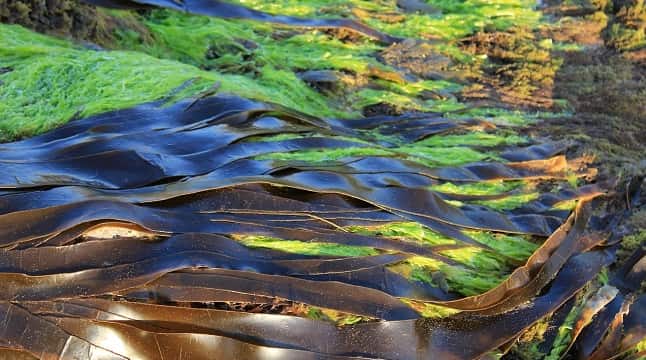
Sure, they aren’t the same thing, but they’re close enough for our purposes today to include together. You’ll find seaweed and kelp attached beneath the waves in coastal regions, and sometimes it’ll be washed up on beaches after storms.
Soak the seaweed in fresh water for a few hours before eating this wild edible plant. It can be eaten raw or cooked, and it contains a tremendous amount of health benefits and dietary supplements.
11. Purslane

Another “weed” for most folks, purslane is a common plant you’ll encounter all over North America.
Chances are it’s growing in your driveway right now or your sidewalk. You’ll also find it growing in areas that have poor quality soils (think roadsides, embankments, abandoned lots).
Identify this fine-tasting plant by its thick, succulent-like leaves and habit of growing in all directions from a central point. Cook it lightly before eating it.
Be wary of its poisonous doppelganger, the hairy-stemmed spurge. You can distinguish the two by squeezing a stem and seeing if a milky sap is present; if it is, it’s the hairy-stemmed spurge and is poisonous.
Eat Up
We’ve got a nice look at a good assortment of common wild edible plants we can eat when in a rough situation or even when gallivanting through the woods on a fishing trip or a hike.
Always practice safety and foraging ethics when ingesting any wild plant, and keep a log of what you’ve found and where you ate it.
The information can be invaluable if you ever need to revisit a food source in the future.
Recommended Reading:
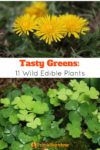


Are pink day lilies edible?
I read in a readers digest health guide that potatoe sprouts are poisonious.What do your books say?
Yes they are poisonous and can cause vomiting and diarrhea.
Had a chuckle at the ‘stomach ache’ warning. One of my great aunts had Royal Ann cherries. We kids would always ask if we could climb the trees and eat some. She always said, “yes, but don’t eat to many or you’ll get a stomach ache” We always ate loads, and never, ever, got the promised stomach ache!